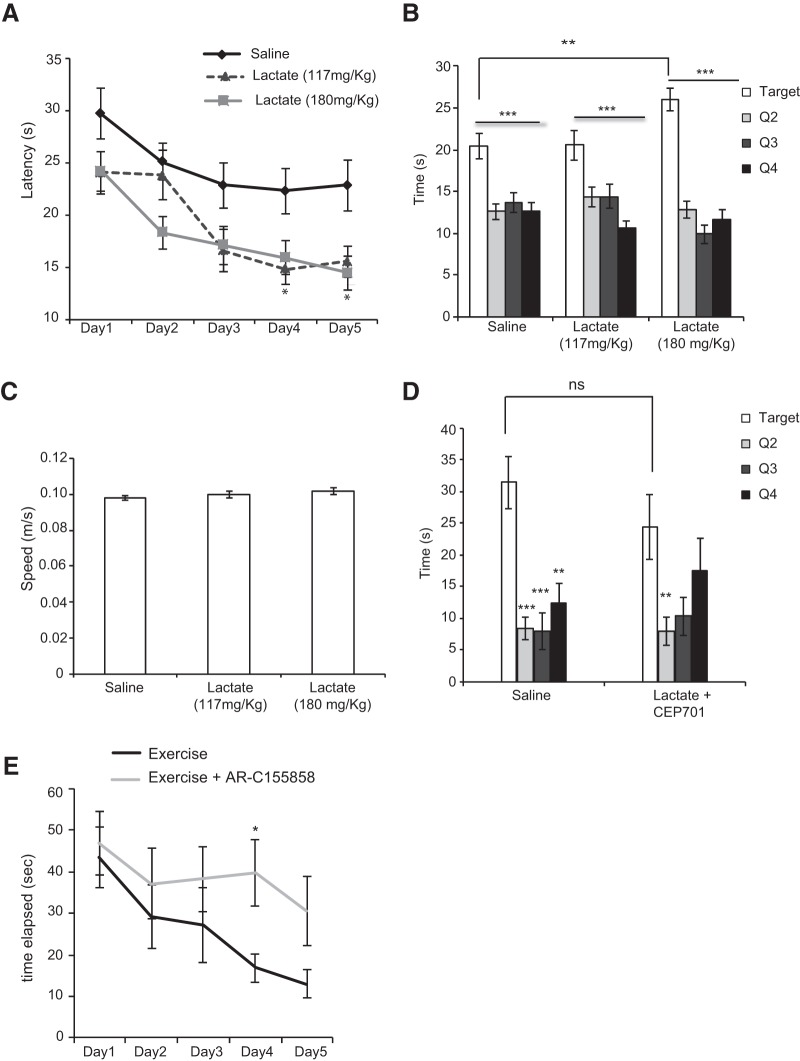Figure 4.
Peripheral delivery of lactate promotes learning and memory. A, Animals were trained for 5 d in a spatial version of the MWM. Animals receiving intraperitoneal injections of lactate (118 and 180 mg/kg) showed significantly reduced escape latency or the time (seconds) required to escape. Results are expressed as mean ± SEM. *p < 0.05 (two-way ANOVA followed by the Bonferroni post-test). B, Animals receiving intraperitoneal injections of lactate (180 mg/kg) spent significantly more time in the target quadrant during a 60 s probe test performed 1 d after the last training session. Results are expressed as mean ± SEM. Statistical significance between the target and the other three quadrants: ***p < 0.0001 (one-way ANOVA followed by Dunnett's post-test). Statistical significance between the target quadrants in saline and lactate-receiving mice: unpaired t test (p = 0.0056 and df = 65). C, The swimming speeds (meter/seconds) of the animals receiving intraperitoneal injections lactate were similar to those receiving saline, indicating that the effects observed in the training and probe test phase were not due to differences in motor behavior between the two groups of animals. D, Animals receiving intraperitoneal injections of lactate (180 mg/kg) in combination with the TRK inhibitor, CEP 701 (3 mg/kg), did not spend significantly more time in the target quadrant compared with animals receiving intraperitoneal injections of saline during a 60 s probe test performed 1 d after the last training session. Results are expressed as mean ± SEM. The number of animals used in each group is 5. Statistical significance was measured by the unpaired t test (p = 0.3117, df = 8). As expected, animals receiving saline spend significantly more time in the target quadrant. Statistical significance was measured by one-way ANOVA followed by the Dunnett's post-test; p = 0.0002 for target versus Quadrant 2 (Q2) and 3 (Q3) and p = 0.0014 for target versus Quadrant 4 (Q4). In contrast, animals receiving lactate and TRK inhibitor CEP701 did not spend significantly more time in the target quadrant compared with Q3 and Q4. One-way ANOVA followed by the Dunnett's post-test; p = 0.0295 for target versus Q2, p = 0.0652 for target versus Q3, and p = 0.4912 for target versus Q4. E, Inhibition of the lactate MCT transporters abolishes exercise-mediated spatial learning in the MWM paradigm. Exercise animals receiving intraperitoneal injections of the lactate MCT transporter inhibitor, AR-C155858 (50 nm/mouse) showed significantly increased escape latency or the time (seconds) required to escape compared with exercise animals receiving intraperitoneal injections of saline. Results are expressed as mean ± SEM. *p < 0.05 (two-way ANOVA followed by the Bonferroni post-test). **p < 0.01.

